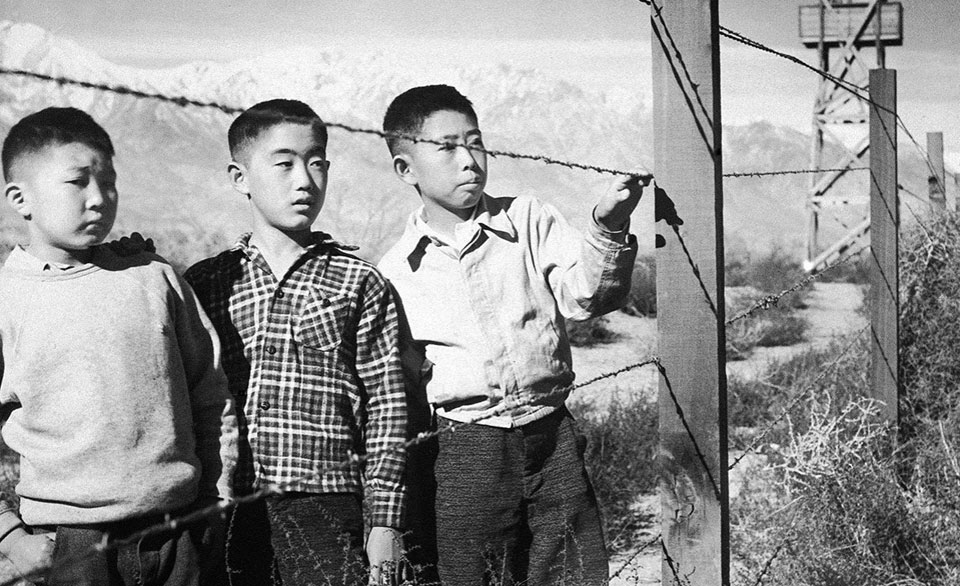
What does it mean to be an American? Who gets to decide? When the world is against you, what can one person do? These are the questions that emanate from George Takei’s new graphic novel account of life as a child in two Japanese internment camps during World War II. Takei, well-known for his inspiring role as Star Trek’s Hikaru Sulu, now shares his tragic childhood experience in the form of an illustrated memoir. The time has never been more relevant to bring to light the wrong that had been dealt to Americans of Japanese ancestry during World War II, simply based on their ethnicity. Readers will learn and contemplate about this dark stain on American history.

Immediately following the Japanese attack at Pearl Harbor on December 7, 1941, President Franklin D. Roosevelt addressed the nation. That same day, the president signed a proclamation declaring that every adult Japanese citizen inside the United States was now an alien enemy and must follow strict regulations. George Takei’s father, Takekuma Norman Takei, was raised in the United States but had been born in Japan. At that time, Asian immigrants were forbidden from applying for U.S. citizenship. On February 19, 1942, Roosevelt signed Executive Order 9066 authorizing the military to declare areas from which any or all persons may be excluded. Ten days later, California and portions of Washington, Oregon, and Arizona were declared a military area.
The book starkly depicts exactly who would be excluded from those military areas: All persons of Japanese ancestry. Curfews were instated and Japanese Americans were soon relocated to designated camps far away for the duration of the war. Solely because of their ethnicity, they were to pay a heavy price. Financial accounts were frozen. Houses, businesses, and property were hastily abandoned. This changed lives forever—innocent lives.
George Takei shows us what life was like from the point of view of a child in 1942, taken away from home along with his brother, sister, and parents, on a train ride far away. The Takei family was transported to Rohwer War Relocation Center in rural Arkansas, the easternmost concentration camp for Japanese internees. This was a long way from their family home in Los Angeles.
From a child’s eye, it initially seemed like an impromptu vacation filled with adventure. Takei reflects on happy hours playing games and eating goodies on the train. He then adds, “Childhood memories are especially slippery. Sweet and so full of joy, they can often be a misrendering of the truth. For a child, that sweetness…out of context and intensely subjective…remains forever real. I know that I will always be haunted by the larger, vaguely remembered reality of the circumstances surrounding my childhood.”

George Takei’s father volunteered as a block representative to improve living conditions in the internment camp, which was now their new home. A year later, in 1943, the U.S. government decided to again allow Americans of Japanese descent to serve in the military. Furthermore, all internees over the age of seventeen had to sign “yes” or “no” to a loyalty oath swearing unqualified allegiance to the United States of America. Both George Takei’s mother and father signed “no.”
George Takei explains how his father could not sign a loyalty oath to a nation that was currently imprisoning him for no crime. His father never forgot the indignation of sleeping in unsanitary horse stalls at Santa Anita Park before boarding the train to Rohwer. Takei’s mother, Fumiko Emily Nakamura, an American-born citizen, married a man her own country rejected and now called an enemy alien. Her country took everything her family had and put them behind fences.
There was a price to pay for signing “no” to the loyalty oath. The Takei family was transferred to the Tule Lake Segregation Center in California on May 14, 1944. This was a maximum-security segregation camp for Japanese Americans who were considered disloyal to the government. George Takei states, “Tule Lake was the most notorious, the cruelest, and by far the largest of the ten camps…so we ended up here…all imprisoned…driven to outrage by a government’s hysteria.”
The graphic novel describes the dilemma the Takei family faced when the Renunciation Act of 1944 became law, offering Japanese American citizens who refused the loyalty oath an option to renounce their citizenship and be expatriated back to Japan. While George Takei’s father was not a legalized citizen, his mother was, and the book recounts her harrowing time deciding what would be best for her family.
They Called Us Enemy takes readers beyond World War II, touching on subsequent decades. George Takei went on to study theater at UCLA. He was passionate about performing in a civil rights musical titled Fly Blackbird! One of his most unforgettable encounters was meeting Dr. Martin Luther King, Jr. while performing songs from the show during a rally at the Los Angeles Sports Arena on June 18, 1961. Takei also reflects on meeting Gene Roddenberry and accepting the role of Sulu in Star Trek, which would change his life. Takei explains, “Hollywood and television had a long history of unflattering stereotypical depictions of Asian men. Gene Roddenberry sheepishly apologized for this legacy…as he offered me the best opportunity I’d ever had.”
In 1988, the United States finally made restitution through legislation for Japanese Americans who were unjustly subjected to the internment camps. Speaking in 2017 at the Franklin D. Roosevelt Presidential Library and Museum, George Takei came to terms with the reality that he was visiting the home of the president who signed Executive Order 9066. Takei recalls the words of his father, years after the internment, “Roosevelt pulled us out of the Depression, and he did great things…but he was also a fallible human being…and he made a disastrous mistake that affected us calamitously, but despite all that we’ve experienced, our democracy is still the best in the world.”
The constitutionality of Japanese-American internment under Executive Order 9066 was eventually repudiated by the Supreme Court in 2018. In a cruel irony, it was struck down as a mere side note in Trump v. Hawaii, the very same ruling that upheld Trump’s ban on immigration from Muslim countries. George Takei reveals the correlation between the wrongs of the past and our current crisis of discrimination. Takei’s personal story, in the form of a graphic novel for all ages, is highly relevant to help warn and educate about the evils of prejudice. George Takei’s co-writers are Justin Eisinger and Steven Scott. The black and white illustrations, which perfectly convey grief and emotion, are by Harmony Becker.
They Called Us Enemy strikes to the marrow. Readers may pause and contemplate the horror of innocent people being taken away from the life they know due to political and racial policies they have no control over. The book portrays how prejudices can swiftly intensify during times of war and strife.
Imagine being arrested simply for being a Japanese language teacher or a Buddhist minister. George Takei makes this very clear and continues to speak out boldly as a social activist. His Broadway musical Allegiance covers some of this same ground in lyrical form. He has also been a leading voice for LGBTQ rights.
Regardless of the time period this memoir depicts, prejudice knows no boundaries, and must constantly be confronted.












Comments